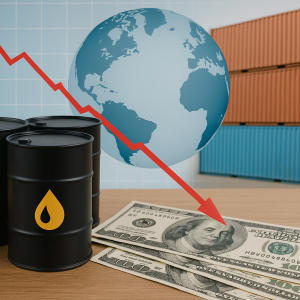Share on
World GDP will continue to expand moderately, decelerating slightly in 2025 The global growth scenario taken as a reference in this forecast report assumes a slowdown in the US, almost entirely offset by the improved dynamics in the Eurozone and growth in the emerging markets (Table A). For the US, in fact, a soft landingwith growth slowing from +2.5% in 2023 to +2.3% in 2024 and +1.5% in 2025. Emerging market dynamics are revised slightly upwards in 2024 compared to expectations in April, due to better trends for some economies, including Argentina, Turkey, Poland and Russia. However, if we look at the top five emerging economies, primarily China and India, the dynamics are slowing slightly from 2023.

The Eurozone's growth gap with the other two big global players is widefrom pre-pandemic (end of 2019) to mid-2024, Eurozone GDP increased by +3.9% compared to +10.7% in the US and +22.8% in China. Even in the current year, the pace of European growth (+0.2% in Q2 over Q1) remains well below that of the US and China (both +0.7%). Europe is grappling with a sharp drop in investment and a slowdown in household consumption, both linked to high interest rates. The industrial business confidence index has been recessive for 19 months and reached its lowest point since August 2020. It is only in the second half of next year that the easing of monetary policy, which will return to neutral at the end of 2025 (-200 basis points from last June to the end of 2025), will incisively unfold its effects, along with the recovery of household purchasing power.
World trade in goods is expanding again in the first seven months of 2024, after the setback in 2023, and is expected to consolidate, returning to pre-pandemic rates. This is thanks to more robust demand fuelled by the return of inflation, which supports households' purchasing power and confidence, and the fall in interest rates in the main areas, which will allow for a gradual rebound in credit and improved investment dynamics. The global demand trend is driven by foreign purchases by the United States (the world's leading importer) and sales by China (the world's leading exporter).
Decoupling signals continue In China, a gradual decline in imports is taking place, which contrasts with the robust growth in exports and industrial activity. These are signs, on the one hand, of weak domestic demand and, on the other, of the shift of production processes upstream in the supply chain within national borders and, therefore, less dependence on foreign inputs. There are also increasing signs of decoupling between China and the US (less weight of cross-purchases) and, more recently, between China and the European Union; at the same time, EU-US trade connections are strengthening.
Various factors persist that fuel global tensions and have negative effects on commodity prices and trade: still high rates, energy prices higher than pre-2022, wars in Ukraine and the Middle East (freight rates for Asia-Europe and Asia-US routes well above 2023 levels, more than doubled in the case of Atlantic routes), increasing protectionist measures (more than twice as fast as before 2020), high uncertainty in multilateral relations, also fuelled by the upcoming US presidential elections. In addition to energy and wars, in Europe there is the crisis of theautomotive which is weakening industrial activity, especially in Germany.
Various factors will affect positively on dynamics of the economy italy-na in the two-year period: the recovery of international trade, between the second part of 2024 and, in particular, 2025; the loosening of monetary policy, which will have positive effects on the investment choices of businesses and household consumption choices progressively and especially in 2025; a moderate strengthening of growth in the Euro Area, substantially in line with that expected for the Italian economy an improvement in households' real disposable income due to the further expansion of employment, the return of inflation and the progressive recovery of real wages; the implementation of the NRP (9.5 billion spent so far this year out of the 42.2 billion planned), which, although it assumes only partial spending of the planned resources (half this year and two-thirds next year, for a total of about 60 billion out of more than 100 billion planned), will make an important contribution to growth. Acting in the opposite direction will be the persistent fragility of the German economy, the leading market for Italian exports (-5.4% Italian exports in the first seven months of 2024); global tensions; and the waning, especially next year, of the boost provided by building incentives.
Growth slows in Italy following Istat revision The CSC forecasts for the Italian economy are revised downwards, by 1 and 2 tenths of a point per year respectively, compared to those included in last April's report: GDP is expected to grow by +0.8% in 2024 and +0.9% in 2025 (Table B). A growth rate, however, higher than that recorded by Italy, on average, in the pre-pandemic decades.

According to the recent extensive ISTAT revision of national accounts data, Italy grew by +0.7% in 2023, not +0.9% as previously estimated. Moreover, although the GDP dynamics in the first two quarters of 2024 remained unchanged, the worse end of 2023 results in a zero statistical legacy in 2024 (previously +0.2).
Supply-side GDP growth this year comes from services (+0.6% in Q2 after a strong increase also in Q1 of +0.8%), all other sectors down. In Q3 2024, activity in services is slowing down but should strengthen in the later part of the year and then in 2025 thanks to moderate inflation, rising real disposable income of households and improved conditions for access to consumer credit. Construction on the housing side is being strongly affected by the reduction of incentives in 2024 and will be even more strongly affected in 2025 when other tax breaks come to an end. Those on the non-housing side, on the other hand, are expected to benefit from the resources of the NRP and less onerous bank loans. In the two-year period, however, the effect of the decline in housing will prevail.
Industrial production in 2023 decreased by 2.4% and in the first eight months of 2024 by a further 3.2% (compared to the corresponding months of 2023). In Q3 it remained negative, with a decrease of 0.5% in August. At the sectoral level, very different performances emerge with growth in other transport equipment, repairs and installations (+8.0% and +5.3% in the first eight months of the year compared to the first eight months of 2023), food and paper (+2.7% and +1.9%), while the contraction in automotive (-17.9%), leather goods (-15%) and clothing weighs heavily. The added value of the industry in the narrow sense is expected to recover next year (-0.8% in 2024, in line with the acquired, +1.0% in 2025), thanks to the recovery of demand, domestic and foreign, however modest, between the end of the year and the beginning of 2025.
Yes fermano this year (+0,5%) e will go down the year next (-1,3%) the atdressingafter the robust growth of previous years (+21.5% in 2021, +7.5% in 2022 and +8.5% in 2023). In the first half of 2024 they slowed down due to the zero contribution of those in housing, but the negative contribution of those in plant and machinery also had an impact. In the second half of the year, the dynamics are expected to turn negative due to the fall in residential construction, which will be exacerbated in 2025 when the other construction incentives also expire or return to ordinary rates, and despite the positive impact of the interest rate cut. The decline (-15%) will bring housing investment in 2025 back to a level somewhere between 2021 and 2022, corresponding to 2008 values. Partially offsetting this will be the expenditure related to the implementation of the NRP, which will reinforce investment in non-residential buildings, and the recovery of investment in plant and machinery, as early as the second half of 2024, which will concern investments delayed by the pending Transition 5.0, a measure that presents some application difficulties (the demonstration of energy savings, the unclear definition of the rules for cumulation with other measures financed by European resources, and the exclusion from the incentive of part of the production system in compliance with the Do No Significant Harm). In addition, both the cut in interest rates and the improved economic outlook will have a positive effect on all investment components.
Disposable income on the rise but consumption held back by the replenishment of savings spent in previous years. Household expenditure on goods and services returned to pre-Covid levels due to the very good growth in 2023 (+1.0% on average per year). In the first half of 2024, it grew again, albeit to a very limited extent (+0.2% per quarter on average). Spending on goods, which decreased last year (-1.3% on average), is also slowly rising.
Household disposable income in real terms declined slightly in 2023 (-0.2% per annum) but grew in the first half of 2024 (+2.2% ac- quired in Q2) due to the continued expansion of employment, strengthening wage dynamics and moderate inflation. The high propensity to save, which came in well above 'normal' values (10.2% in Q2, compared to 7.9% in 2015-2019) is dampening consumption and reflects the intention of households to replenish savings spent in previous years (due to high inflation) and the uncertain geopolitical environment. Looking ahead, households should gradually tend to normalise their savings rate and increase consumption. In addition, the rate cut already initiated and expected to continue will act favourably both on lending and by reducing household costs, with positive effects that will be most evident in 2025.
The annual dynamics of consumer prices in Italy (0.7% per year in September, to +1.1% in 2024) is the lowest among major European economies (+1.7% in the Eurozone) and remains well below the ECB target of +2.0%. For this reason, the still high interest rates in Italy are more restrictive than elsewhere in real terms. In 2025, inflation in Italy is expected to rise somewhat, tending to come close to the values of the core measure, i.e. just below +2.0%.
Expected decrease in hours worked per employeeThis will partially offset the strong extension of working hours observed in recent years and in the light of a number of factors, both cyclical (slowdown in construction activity and weakness of the industrial sector) and structural (shift of activity and employment towards services, characterised by shorter working hours). This will lead to a slight improvement in labour productivity: +0.6% that per hour worked in 2025, after declines in previous years (-0.6% in 2024 and -1.5% in 2023). This is especially the case in industry, where the phenomenon of no-growth employment observed since 2022 seems to have come to an end (and recourse to the Wage Guarantee Fund is increasing), and in services, where a re-composition in favour of the highest productivity sectors (information and communication and professional, scientific and technical activities and support services) has been underway since 2022. On average for the year, as in 2023, employment in terms of equivalent units (ALU) will grow at a faster pace than economic activity in 2024 (+1.4% for ALU against +0.8% for GDP). Already by the middle of this year, however, and in 2025, ALUs are expected to advance at a slower pace than GDP (while the number of employed people will continue to increase as GDP).
Nominal wage dynamics, together with the return of inflation, will allow a gradual recovery of real wageswhich will advance by +4.3% in 2024-2025, after -6.7% in 2022-2023. The upswing already started in 2023, driven by the private sector, where real wages per AWU in Q2 2024 had recovered the 40% of the loss in purchasing power generated by the surge in inflation (-5.0% over Q1 2021, from a low point of -8.3% at the end of 2022). This was due to the acceleration of contractual wages, which occurred earlier and was more extensive in industry (where the coverage of collective bargaining agreements was almost complete in the two-year period 2022-2023) and based on the virtuous mechanism for adjusting minimum wage rates defined between the social partners in 2009, which allowed for a faster return to inflation than in other European countries. On the contrary, in the public sector, reflecting two rounds of widely delayed renewals of collective labour agreements, real per capita wages fell even more as prices soared (-13.2% in Q1 2023 on Q1 2021) and only started to recover from the second part of 2023, settling in mid-2024 at a level still almost 9 percentage points below that of the beginning of 2021.
ULC in Italian manufacturing rises again driven by wage acceleration at the same time as the contraction of labour productivity: +5.6% in H1 2024 over H1 2023, after +5.9% on average per year in 2023. The improvement in labour productivity in 2025 will dampen the pace of growth of the Clup, which is nevertheless still expected to expand by about 3 points, given the sustained wage dynamics.
Export of goods stagnated in the first seven months of 2024 (-0.1% compared to the same period in 2023, after -1.2% last year) due to falling European demand (which absorbs 52% of Italian exports). This is the result of an increase in sales in non-EU markets (+1.8%), also thanks to the +3.3% to the United States (the second largest destination country for Italian sales), and a decrease in EU markets (-1.6%), with a decrease of -5.4% to Germany (the largest outlet country). Despite this, Italian exports performed better than their potential demandgaining market share in their destination markets. Italian imports of goods are falling sharply this year, suffering from the weakness of domestic demand for consumption and especially investment, especially in machinery, as well as the stagnation of exports themselves. For this net exports make a strong contribution to GDP growth in the current year (+1.2 percentage points) and remains marginally positive in the coming year (+0.1 points) when exports and imports of goods are expected to restart at a moderate pace favoured by an improvement in world and especially European manufacturing activity (however below world trade). The contraction in purchases from abroad this year of energy goods (gas and oil, equal to 11% of Italian imports in 2023) is significant, favoured by an earlier accumulation of stocks and mild winter temperatures, reduced by more than a fifth, at constant prices, compared to the same period in 2023, contributing more than half to the drop in total imports.
The excellent export performance is the result of a series of adjustments over the last 10-15 years: the contraction of the production base between 2011 and 2022 of -16% (67 thousand enterprises) which affected the micro-small classes while the number of medium and large has increased since 2015; the rebalancing of productivity compared to other European companies mainly due to small and medium-sized companies (between 10 and 249 employees) whose efficiency advantage over their German and French counterparts has almost steadily increased (the group of 'best' producers is made up of just under 20% of Italian manufacturing companies, which employ more than 50% of the workforce and produce around 50% of the added value) the increase in the share of exporting companies from less than 21% in 2011 to more than 22% in 2022 because exporters decreased less than the others, also accompanied by an increase in average exports per company regardless of size class.
The knots of competitiveness. Several factors threaten the country's growth in the coming years.
Demographic decline will increase the shortage of workers, which is already a problem todayBefore the pandemic there were recruitment difficulties for 26% of expected hires (1.2 million), while in 2023 the share exceeded 45% (almost 2.5 million). Factors such as low internal mobility, the brain drain and the shortage of non-EU workers tend to increase the problem. Based on ISTAT demographic projections, the natural balance of Italy's resident population is expected to decrease by 1.5 million between the beginning of this year and 2028. Despite the positive migration balance with foreign countries expected at 1.2 million, the population of working age will be 850,000 less. With the same employment rate, the labour supply in five years' time will shrink by 520 thousand. Modest economic growth (of 4.9% cumulative in 2024-2028) would imply an additional employment requirement of about 815 thousand. The mismatch, therefore, could widen by 1.3 million in 2028. At the territorial level, it would be more contained in the North, below the national average in the Centre, while it would be accentuated in the South. It is difficult to think of compensating for this with the increase in the employment rate alone, which is expected to rise by 3.7 percentage points. Assuming an increase in the employment rate of two points (a more plausible objective over a five-year period), there would still be a shortfall of 610,000 units that would have to be found by expanding the number of foreign workers entering the country by about 120,000 more per year, if the availability of workers is not to limit the growth of economic activity.
Housing costs that are too high in relation to productivity and thus wages, in the different territorial areas, restrain the mobility of workers. Housing costs are a key factor in the decision to move to another region for work. In an ideal market, housing costs should be proportionate to the level of productivity in the region and thus to average wages. House prices that are too high relative to productivity, even in areas with high labour demand, create a barrier for workers to move to such areas. In Italy, this problem is particularly evident in some provinces such as Milan, Como, Venice, Bologna, Florence and Rome, as well as in the North-West and Central Italy in general. The paradoxical result is that some geographical areas with high labour demand experience labour shortages, while other areas with lower productivity and fewer job opportunities suffer from high unemployment rates. Measures to support rents and a composite plan, aimed at encouraging the construction or redevelopment of real estate at reduced prices, could help reduce these imbalances and increase labour mobility.
Gas and electricity prices are still higher in Italy than in other major European countries such as France and Germany, and than in the United States penalising the competitiveness of companies compared to their main Western partners. In addition to the measures already initiated, a useful contribution could come from the reform of the electricity market, to separate the price of electricity from that of gas, as well as, in the long term, from the development of nuclear power.
The collapse of the automotive sector, which has roughly returned to the production level of early 2013, given its significance, puts both short- and medium-term Italian growth at risk-26.1% production in July 2024 compared to July 2023 against -3.8% for total industrial production; in the automotive sector proper, the drop is even deeper (-34.7%). This phenomenon, although linked to the weakness of demand, is not only cyclical (imports of motor vehicles into Italy increased, albeit slightly, by +2.0% trend-wise). There is also some change in habits that reduces demand: among young people there is a lower desire to use a car than in previous generations; there is a strong growth in the vehicle-sharing. But cost also certainly plays a role: in Europe in 2023, the cheapest electric car on the market was 92% more expensive than its cheaper internal combustion counterpart, due to the batteries, which account for about 40% of the total costs; the price differences increase as the size of the vehicle decreases. Taking two alternative powertrains of the same small car as a reference, over a period of 10 years, including all costs, switching to the electric car means a cost increase for an Italian motorist of about EUR 5,700, the 15% more. In addition, recharging times are higher, the range is significantly reduced, the availability of recharging infrastructure is still limited, and battery performance is progressively reduced. The association between the ongoing transformation and the collapse of production in the automotive sector does not seem to be coincidental. But the sector is too important for the Italian and European economies: the 'core' sector alone accounts for 13% of European manufacturing turnover, 6.3% of Italian manufacturing production, an added value of 15 billion and 170,000 employees in Italy. And that's without counting all the domestic allied industries generated (with which the sector weighs 5.6% of the overall added value according to Anfia), which mainly involve the metal products industry, but also rubber-plastics, metallurgical activities, the manufacture of machinery and electrical equipment.
The increasingly stringent ETS in parallel with the operation of the CBAM increases the risk that some of the regulated manufacturing activities, which account for 9% of manufacturing value added in both Italy and the European average, will be relocated outside the EU. The EU has set a revised, annually reduced cap on total allowances that will lead to a reduction of 62% by 2030 compared to 2005 levels. The significant reduction of allowances in circulation and the possibility for operators outside the scheme to purchase the EU allowances have led to a very significant increase in the purchase price of quotas: from the beginning of 2021 until today, the price has increased by 42%, resulting in a competitive disadvantage for European companies. This disadvantage was already evident in 2021, when carbon prices applied to steel, aluminium and cement production in EU countries were generally higher, often substantially so, than in import and export markets, while it was lower for countries outside the system such as the US. According to a simple simulation conducted by the Centro Studi Confindustria, the elimination of free allowances used in the ETS by Italian companies in 2022 would lead to an average increase in direct production costs of 3% for regulated companies. The average increase would exceed 5% for firms producing derivatives from oil refining and products obtained from the processing of non-metallic minerals (refractory products, cement, concrete, gypsum, glass, ceramics, etc.), and 7% for the 25% of the most exposed firms. If one also considers the already existing effect of the ETS on the cost of electricity, which creates a competitive disadvantage for the entire EU, one understands the enormous criticality of this mechanism and the impact it could have on the propensity of companies to invest in Europe.
The entry into force of the CBAM from 2026, which will impose a carbon tax on imports of a group of emission-intensive products, such as pig iron, iron, steel, aluminium, cement, fertilisers, electricity and hydrogen from non-EU countries, presents the same risks. EU imports from non-EU countries in the sectors that will be affected by the CBAM tax are more than 4% of the total imported outside the single market and feed a trade deficit of around EUR 15 billion. Italy is, among the main European manufacturing countries, the one with the highest exposure, accounting for 7.5% of total imports, and has an extra-EU trade deficit of -5.0 billion in these products, although it has a surplus when considering trade within the single market. As European companies compete in contexts where carbon is either not priced (e.g. several US states) or has a lower cost (e.g. China), there will be a loss of competitiveness in these markets. Moreover, the application of the tax upstream in the production chain, insofar as it affects goods that in many cases represent semi-finished or raw materials and not finished products, ends up penalising, de facto, European industry, which is, primarily, a processing industry. Lastly, in addition to being easily circumvented, its application requires a range of information that increases the administrative burden throughout the production chain, especially for small and medium-sized enterprises, and the lack of an unambiguous method of calculating emissions increases the risk of penalties for companies that fail to meet the requirements.
































